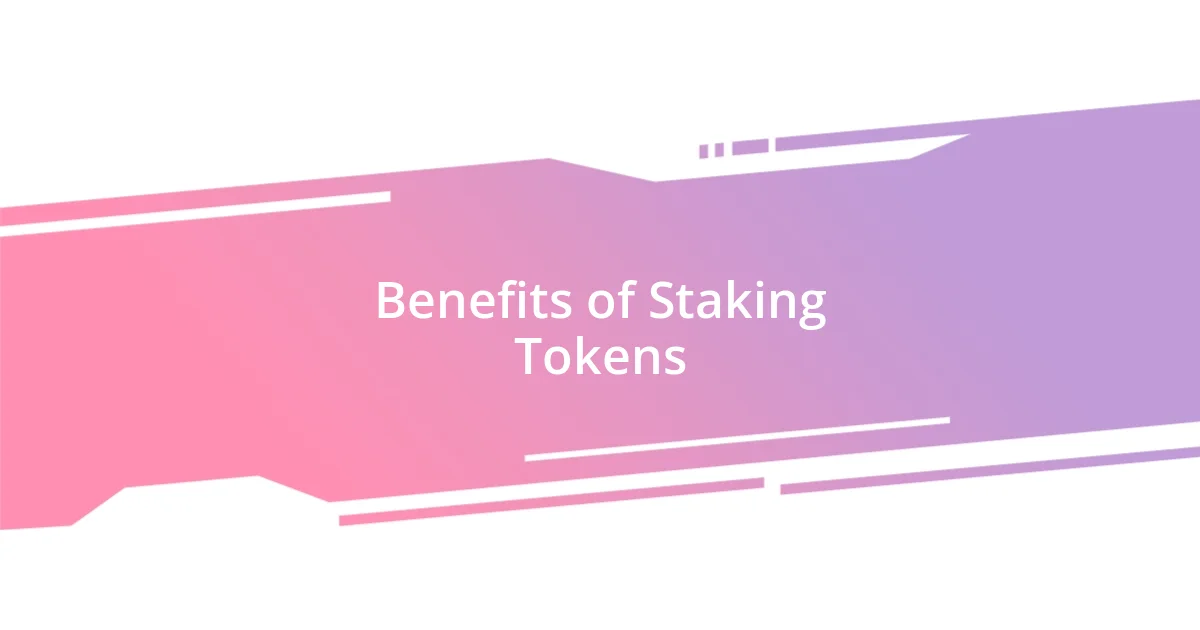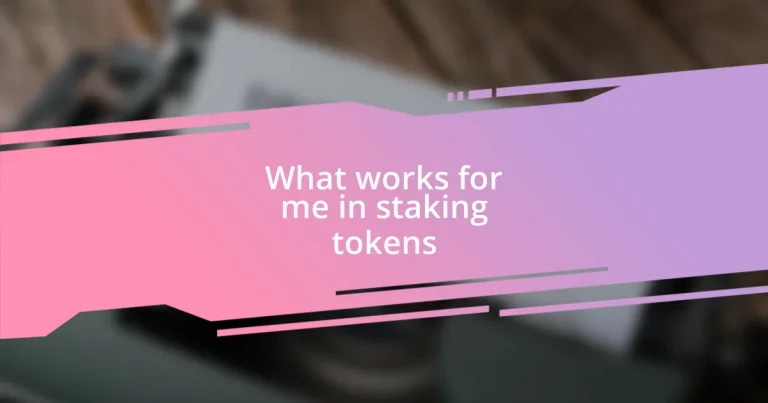Key takeaways:
- Staking tokens involves locking assets to support blockchain networks, offering a blend of financial rewards and community engagement.
- Key benefits of staking include earning passive income, participating in network operations, and fostering a sense of community among stakeholders.
- Effective staking requires careful selection of tokens, risk management, and ongoing performance tracking to maximize returns and ensure informed decision-making.

Understanding Staking Tokens
Staking tokens refers to the process of participating in a proof-of-stake blockchain network by locking up a certain amount of tokens to support the network’s operations. When I first started staking, the idea of “locking up” my funds felt daunting. Would I ever see my tokens again? But as I learned more about how this mechanism helps secure the blockchain and even earns rewards, my apprehension turned into excitement.
Engaging with staking means I was not just holding my assets passively; I was actively contributing to the network. I remember the rush I felt after seeing my first rewards. It was a tangible reflection of the effort I’d put in, and it made me realize that participating in the cryptocurrency ecosystem can be rewarding both financially and emotionally. Have you ever felt that thrill when your efforts yield results in other areas of your life?
Moreover, staking isn’t just a way to earn passive income; it’s also about making informed choices. Each token has different staking requirements and risks. Finding a balance for my risk tolerance was essential. Sometimes, I would dive into forums or chat groups, feeling the pulse of the community, all while trying to figure out which tokens felt right for me. It reminded me that staking is not just a technical process but a shared journey with others navigating the same waters.

Benefits of Staking Tokens
Staking tokens has some compelling benefits that can transform your crypto experience. One of the most immediate perks is the opportunity to earn passive income. I recall vividly the first time I saw my staking rewards accumulate; there was a sense of accomplishment that came from making my assets work for me. It felt empowering to know that while I wasn’t actively trading, my tokens were still generating value.
Here are some key benefits of staking tokens:
- Passive Income: Earn rewards while your tokens are staked.
- Network Participation: Play a crucial role in supporting blockchain operations.
- Potential for Capital Growth: As more people enter the market, the value of your assets may increase.
- Lower Volatility: Staking offers some stability compared to regular trading.
- Community Engagement: Join discussions and connect with like-minded stakeholders, enriching your experience in the crypto space.
When I think about staking, I also remember the thrill of being part of a community. It’s not just about the tokens; it’s about banding together with others who are as passionate about the technology as I am. I love watching how the decisions I make affect the overall ecosystem. Seeing those rewards appear in my wallet confirms that my contributions really do matter.

Choosing the Right Tokens
Choosing the right tokens for staking is a crucial step that can significantly impact your overall experience and rewards. Based on my experiences, I’ve discovered that not all tokens are created equal. For instance, some tokens may offer higher rewards but come with increased risks. It’s essential to assess the project’s fundamentals, like its purpose, technology, and team behind it. I remember feeling overwhelmed by the sheer number of options, but focusing on these key indicators helped narrow down my choices.
I once invested in a staking token that seemed promising, but after further research, I realized that the project lacked a strong community backing. This taught me a valuable lesson: community engagement can often be just as important as technical factors. I suggest considering whether the community actively discusses improvements or addresses concerns, as a robust community can often lead to the token’s longevity and reliability.
In my journey, I’ve learned to compare the staking mechanisms and lock-up periods. Some tokens require a longer commitment, while others offer flexibility. This can be a game changer depending on your personal investment strategy. Always remember to evaluate your own risk tolerance and investment goals before making a decision. It’s like choosing the right path in a maze; assessing all the possible routes can lead you to the best outcome.
| Token Criteria | Examples |
|---|---|
| Community Support | Active Reddit and Discord channels |
| Project Fundamentals | Clear roadmap and experienced team |
| Staking Rewards | 6% APY vs 15% APY |
| Lock-up Period | 1 month vs 6 months |

Staking Strategies for Beginners
Staking strategies for beginners can feel a bit daunting at first, and I know that from my own start in the crypto world. When I was just getting into staking, I quickly learned that diversifying my staking portfolio was key. By spreading my tokens across several projects, I not only mitigated risk but also increased my chances of earning different kinds of rewards. Has there ever been a time when you hesitated over a decision? These moments drive home the importance of research and patience in choosing what to stake.
To give you a peek into my journey, I remember my nervousness when deciding how long to lock up my tokens for staking. I chose a shorter lock-up period initially, allowing me the flexibility to adapt my strategy quickly. It was an empowering choice that gave me confidence as I learned more about the space. Now, I look back and see that calculated risk can often lead to great lessons (and rewards).
Engaging with staking communities has enhanced my experience tremendously. Whether through forums, social media, or local meetups, the conversations I had significantly improved my understanding of different strategies. I often found myself asking questions, learning from the successes and challenges of others. Tyrouble I’ve faced usually served as a great reminder that we’re all in this together, striving for similar goals in the exciting world of cryptocurrency. Have you considered the power of learning from a community?

Managing Risks in Staking
Managing risks in staking requires a thoughtful approach. I vividly remember a time when I hastily staked tokens without fully understanding the platform’s terms and conditions. This led to unexpected penalties and a hard lesson about the importance of reading the fine print. Have you ever rushed into a decision only to regret it later? It’s crucial to take a moment to examine any hidden fees or penalties associated with a stake.
Another strategy that I found beneficial was setting clear investment limits. Early in my staking journey, I realized I was overcommitting to a single project out of excitement. Once I set a budget for how much I was willing to stake in any given project, I felt more secure and in control. This method not only mitigated risk but also helped me focus on long-term growth. How do you determine what you’re comfortable with when investing?
Furthermore, I actively monitor my stakes. In my experience, staying updated with market trends and project developments is vital. I recall a time a major announcement led to a sudden drop in the value of a project I was heavily invested in. I learned that setting aside time regularly to review my staking strategy and adjust as necessary can be the difference between a thriving investment and a fading dream. How often do you check on your investments? Making this a regular part of your routine can significantly enhance your staking experience.

Maximizing Staking Returns
Maximizing returns in staking goes beyond simply selecting a project. I recall when I first began staking, I wasn’t fully aware of the benefits that yield optimization tools could offer. Discovering these tools felt like a game changer; they allowed me to automate strategies and compound my rewards effectively. Have you thought about how technology could streamline your staking process?
Another key aspect I’ve learned is the importance of timing. There was a time when I hesitated to restake my tokens after a significant market event, only to see others thriving while I missed out. Now, I make it a habit to track staking cycles and take action promptly when rewards are at their peak. It’s all about being proactive; how often do you seize opportunities in your staking journey?
Moreover, I find it invaluable to stay educated on governance proposals and community votes within the projects I stake. One particular experience stands out when I voted on a proposal that directly influenced my staking rewards. That moment made me realize the power I had as a stakeholder. Engaging actively in governance not only boosts returns but also deepens my connection to the project. How involved are you in the communities of the projects you invest in?

Tracking Your Staking Performance
Tracking your staking performance is essential for long-term success. In my early days of staking, I didn’t keep close tabs on my performance, which often left me scratching my head about my earnings. It wasn’t until I regrettably realized how many rewards I missed out on due to poor tracking that I vowed never to make that mistake again. Do you feel confident in how you’re monitoring your staking outcomes?
I discovered that using a spreadsheet to log my staked tokens and their specific performance metrics worked wonders. Initially, this felt tedious, but I soon saw the rewards pile up as I made more informed adjustments to my strategy. Each entry on that sheet told a story, and I could easily identify which projects were worth my time and which were lagging behind. What tools or methods do you use to keep your staking data organized?
Furthermore, I learned the importance of setting specific performance indicators. For instance, I aimed for a target return on investment (ROI) percentage monthly. This goal transformed how I approached my staking activities. When I hit my targets, I felt a rush of accomplishment; but I also learned to pivot when things didn’t meet my expectations. It’s an ongoing journey, and I encourage you to ask yourself: how are you holding yourself accountable for your staking goals?














